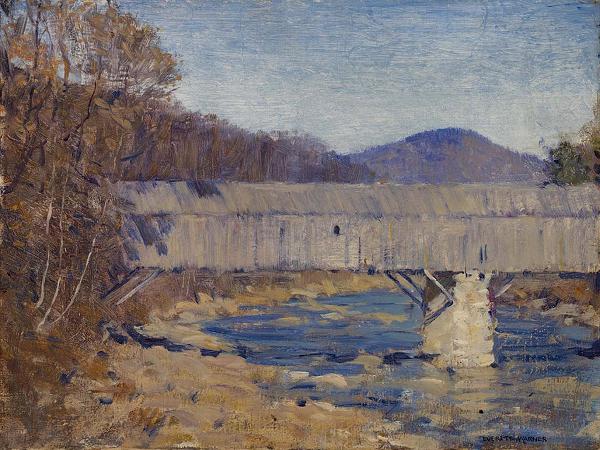Covered Bridge. A covered bridge is a timber-truss bridge with a roof, decking, and siding, which in most covered bridges create an almost complete enclosure. The purpose of the covering is to protect the wooden structural members from the weather. Uncovered wooden bridges typically have a lifespan of only 20 years because of the effects of rain and sun, but a covered bridge could last over 100 years. Once common, only about 1 in 10 survived the 20th century. The relatively small number of surviving bridges is due to deliberate replacement, neglect, and the high cost of restoration. Typically, covered bridges are structures with longitudinal timber-trusses which form the bridge's backbone. Some were built as railway bridges, using very heavy timbers and doubled up lattice work. In Canada and the U.S., numerous timber covered bridges were built in the late 1700s to the late 1800s, reminiscent of earlier designs in Germany and Switzerland. They tend to be in isolated places, making them vulnerable to vandalism and arson. Most bridges were built to cross streams, and the majority had just a single span. Virtually all contained a single lane. A few two-lane bridges were built, having a third, central truss. Many different truss designs were used. One of the most popular designs was the Burr Truss, patented in 1817, which used an arch to bear the load, while the trusses kept the bridge rigid. Other designs included the King, Queen, Lattice, and Howe trusses. Early trusses were designed with only a rough understanding of the engineering dynamics at work. In 1847, American engineer Squire Whipple published the first correct analysis of the precise ways that a load is carried through the components of a truss, which enabled him to design stronger bridges with fewer materials. About 14,000 covered bridges have been built in the United States, mostly in the years 1825 to 1875. The first documented was the Permanent Bridge, completed in 1805 to span the Schuylkill River in Philadelphia. However, most other early examples of covered bridges do not appear until the 1820s. Extant bridges from that decade include New York's Hyde Hall Bridge and Pennsylvania's Hassenplug Bridge, both built in 1825, and the Haverhill-Bath Covered Bridge and the Roberts Covered Bridge, in New Hampshire and Ohio respectively, both built in 1829. The longest covered bridge ever built was constructed in 1814 in Lancaster County, Pennsylvania and spanned over a mile in length, but was destroyed by ice and flooding in 1832. The longest, historical covered bridges remaining in the United States are the Cornish-Windsor Bridge, spanning the Connecticut River between New Hampshire and Vermont, and Medora Bridge, spanning the East Fork of the White River in Indiana. Both lay some claim to the superlative depending upon how the length is measured. In the mid-1800s, the development of cheaper wrought iron and cast iron led to metal rather than timber trusses. Metal structures did not need protection from the elements, so they no longer needed to be covered. The bridges also became obsolete because most were single-lane, had low width and height clearances, and could not support the heavy loads of modern traffic. As of 2004, there were about 750 left, mostly in eastern and northern states. Between 1969 and 2015, the number of surviving covered bridges in Canada declined from about 400 to under 200. In 1900, Quebec had an estimated 1,000 covered bridges. Relative to the rest of North America, Quebec was late in building covered bridges, with the busiest decade for construction being the 1930s.
more...





